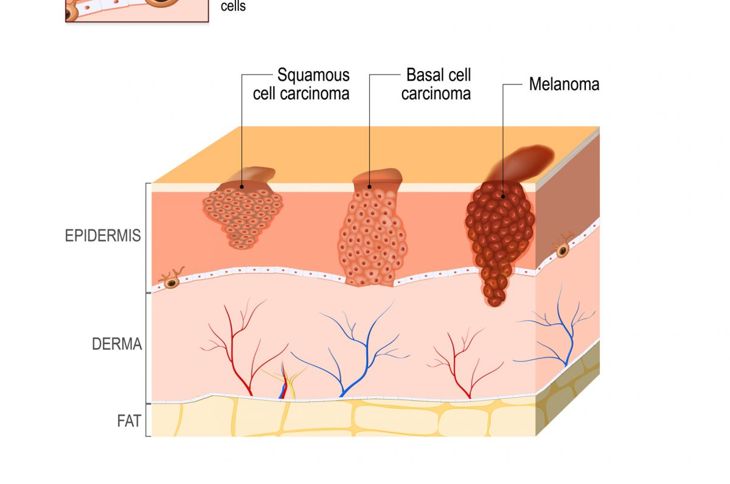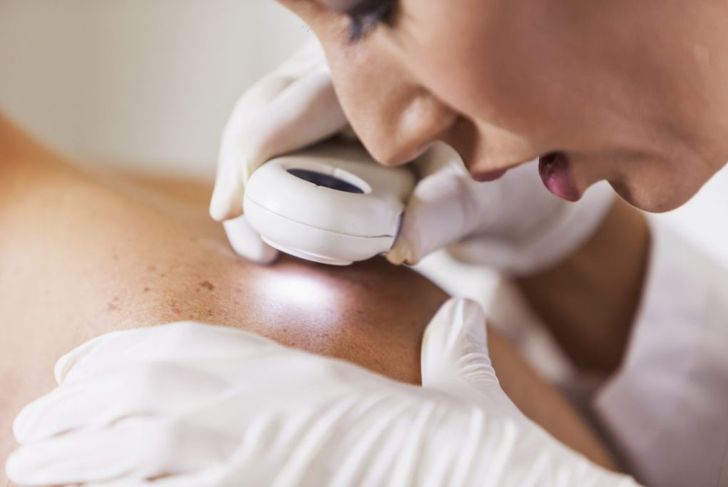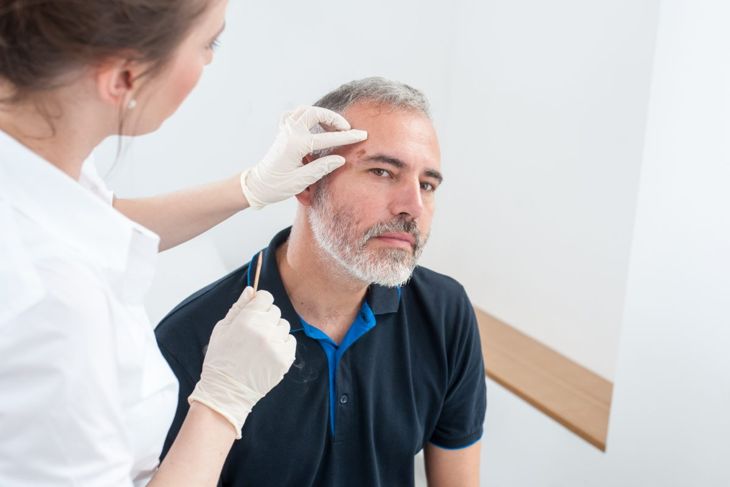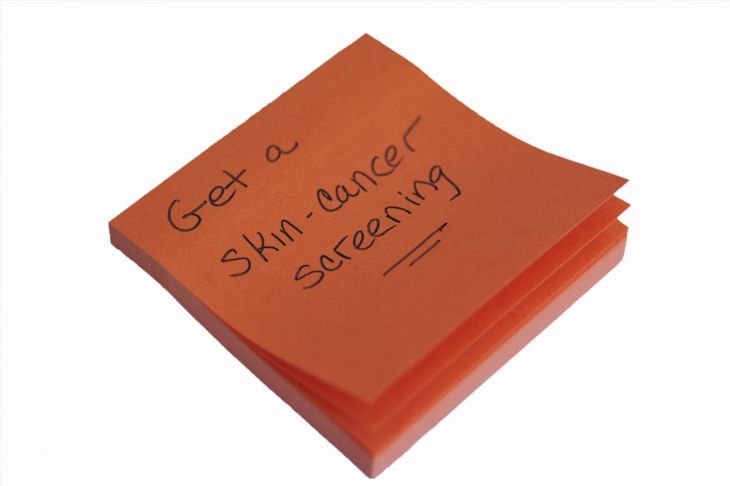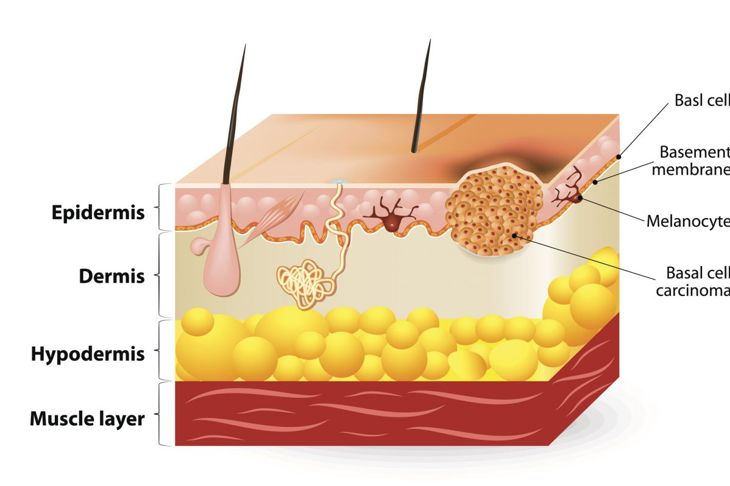Squamous cell cancer (SCC) affects one of three kinds of cells composing the epidermis. Squamous cells lie near the skin’s surface and constantly shed as new cells form. Abnormal changes to their DNA, due to excessive exposure to sunlight, genetics, or other harmful agents, may cause cancer. Most SCCs can be treated when caught in the early stages. When SCC lesions remain untreated, they can become disfiguring or invasive. A dermatologist or general physician should investigate suspicious skin discolorations or growths; if the growth is malignant, early detection can prevent the cancer from spreading.
What Does Squamous Cell Carcinoma Look Like?
Early signs of squamous cell carcinoma include dome-shaped, slightly protruding bumps or scaly, reddish patches of skin. SCC patches bleed easily when scraped or picked. Larger SCCs often itch and hurt when scratched. In some cases, bumps emerge through scars or sores. Changes to these markings should be reported to a dermatologist. Although SCC bumps or rough patches more commonly develop on sun-exposed areas like the face or scalp, they can arise anywhere on the body.
How is Squamous Cell Carcinoma Diagnosed?
Dermatologists perform examinations of possible SCCs, checking their color, shape, texture, and size. They may order skin biopsies if they suspect a malignant growth, which requires removing a small tissue sample to send to a laboratory for tests. During examinations, dermatologists may use a dermatoscope to inspect the lesion more closely. More advanced SCCs can sometimes be identified without a biopsy.
Who is at Risk for Squamous Cell Carcinoma?
Risk factors for SCC include
Fair skin, blue eyes, or blond hair
Excessive exposure to sunlight (UV radiation)
Using tanning beds
A history of serious sunburns
Past diagnoses of precancerous skin lesions, such as actinic keratosis
An immune system compromised by chronic disease or disorders
Age over 50
History of human papilloma virus
Xeroderma pigmentosum is a rare genetic disorder that makes people extremely sensitive to UV radiation. People who carry this gene have a greatly increased risk of developing SCC, basal cell carcinoma, or melanoma. Squamous cell carcinoma is also more common in males.
Treatments for Squamous Cell Carcinoma
When caught in its early stages, squamous cell carcinoma is treatable with minor surgery a dermatologist can perform in their clinic. The doctor may use a number of common techniques to remove noninvasive SCCs
Excision (simply cutting out the lesion)
Mohs surgery (removing layers of the lesion until the cancer cells are completely eliminated)
Dermabrasion (sanding SCC lesions to expose cancer-free layers of skin)
Liquid nitrogen (freezes and destroys the spot)
Cream or gel chemotherapy (treats non-melanomas only)
Superficial radiation therapy (SRT)
The best treatment will depend on the size, location, and depth of the SCC, as well as how aggressive the cancer is.
Complications of Untreated Squamous Cell Carcinoma
Left untreated, SCC may spread and infiltrate nearby skin tissues. Invasive SCC means cancer has spread to lymph nodes or internal organs. Although rarely fatal, the cancer can cause serious health problems and disfigurement. Aggressive SCC is associated with how deep or large the lesion is, whether lesions form on mucous membranes (lips or eyes), and the overall health of the person at the time of diagnosis.
Exposure to UV Radiation
The most common reason for the development of squamous cell carcinoma is ultraviolet radiation. Both types of UV radiation promote SCC. The sun, tanning beds, and sun lamps emit UVA, which is responsible for the tanning the color of the skin. UVB causes sunburns and is mostly responsible for SCC and melanoma. Fair-skinned individuals with a history of severe sunburns, sun poisoning, and blisters are at a high risk for SCC.
What is Low-Risk and High-Risk Squamous Cell Carcinoma?
Dermatologists diagnose low-risk SCC if bumps or lesions are small, superficial, and have well-defined edges. Removal of these growths typically involves topical chemotherapy or excisions performed in-office. High-risk SCC lesions exceed two centimeters and affect the ears, lips, nose, or eyelids. They have a higher potential for spreading (metastasizing) than low-risk SCC. Lesions that extend deeper into the skin (more than 4 mm), those that invade the underlying nerves, and ones located near the parotid gland are also often classified as high risk. People who have a suppressed immune system are also at higher risk of the tumor spreading.
Treating Precancerous Skin Conditions
In some cases, squamous cell carcinoma may emerge from a precancerous condition called actinic or solar keratosis. Beginning as pink, flat, rough lesions on the skin, actinic keratosis areas may rise above the skin and become hard. Skin cancer screenings are vital for detecting actinic keratosis and other precancerous skin lesions. When caught early, they are usually easy to treat with photodynamic therapy or topical chemotherapy.
Basal Cell vs. Squamous Cell Carcinoma
Basal cell carcinoma (BCC) differs from SCC because it affects basal cells only. Basal cells produce new skin cells as old cells die. However, both basal cell and squamous cell carcinoma are caused primarily by long-term exposure to sunlight and tanning beds. Basal cell carcinoma spots tend to look like open sores or patches of eczema or psoriasis. Treatment for BCC involves the same techniques used to treat SCC: excision, Mohs surgery, and topical chemotherapy.
Prognosis
The survival rate for squamous cell carcinoma is quite high, thanks largely to the success of treatment. Even when the cancer has metastasized into the lymph nodes or other nearby structures, many individuals benefit from surgery and radiation. However, there is always a chance that SCC will recur, so regular checkups are vital for individuals in remission.

 Home
Home Health
Health Diet & Nutrition
Diet & Nutrition Living Well
Living Well More
More